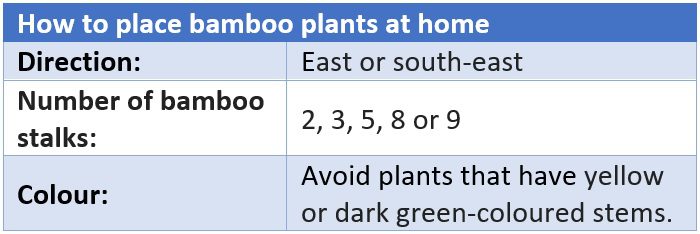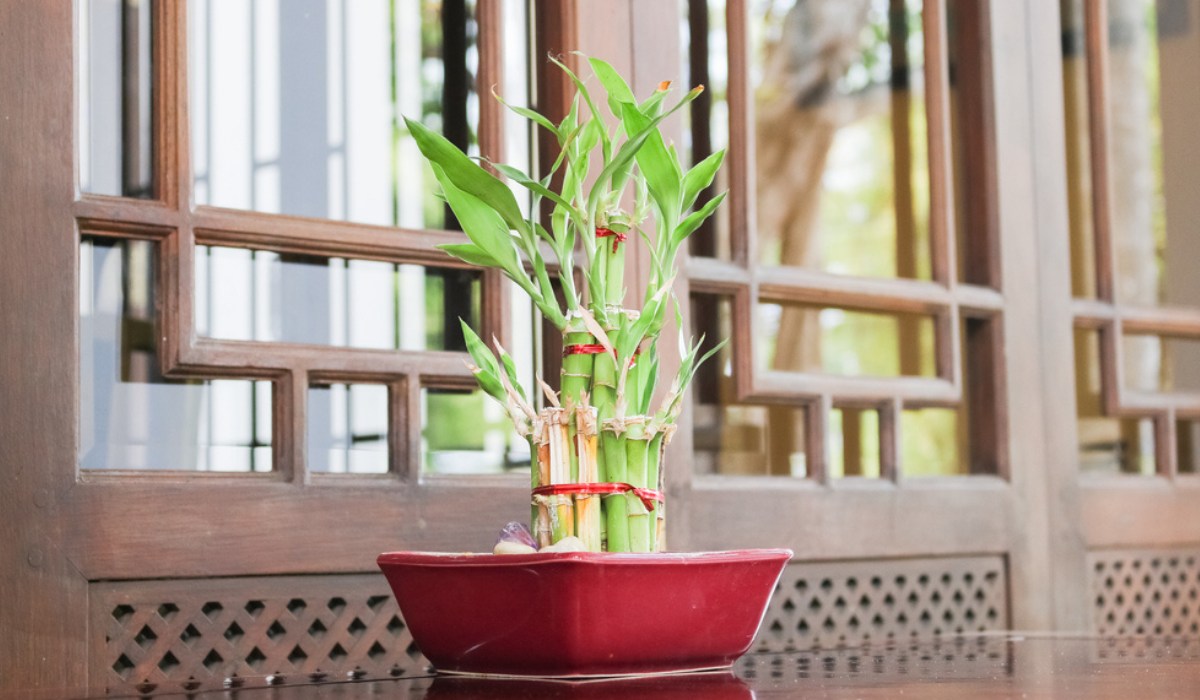Keeping auspicious plants at home is widely believed to bring good luck and prosperity to the house or an office space. According to Vastu Shastra, as well as Feng Shui, the lucky bamboo plant can help create a positive environment if placed in the right direction. Besides, the long green stalks of bamboo look visually appealing when placed indoors. The plant has specific significance based on the number of stalks. The bamboo plant is easy to grow and maintain, making it a great addition to your home. The Feng Shui lucky bamboo is known by different names such as Chinese water bamboo, friendship bamboo, curly lucky bamboo, Belgian evergreen, Goddess of Mercy and Sander’s Dracaena.
Today, bamboo plants are available in different sizes and varieties – from small size ‘friendship plants’, where logs of bamboos are stacked together and tied with a red ribbon and placed in glass vase filled with stones, pebbles and water, to the larger ones with long height and thick stems and leaves. You can find a variety of lucky bamboo plants, which is a tropical water lily-type of plant, in gift shops, as well as nurseries.
As per Vastu Shastra principles, the lucky bamboo plant should be placed in the east or southeast corner in the house. The bamboo plant arrangement also represents the five elements of earth, the foundation of a harmonious universe.
Known about: Trellis: Benefits of growing plants on a trellis
Lucky bamboo: Quick facts
| Common names | Lucky bamboo, ribbon plant and friendship bamboo |
| Botanical name | Dracaena sanderiana |
| Family | Asparagaceae |
| Plant type | Perennial shrub |
| Mature size | 1 to 5 ft in height, 1 to 2 ft in width (indoors) |
| Flower colour | White |
| Origin | Originated in Southeast Asia, around 5,000 years ago |
| Common shapes of lucky bamboo | 2 layer, 3 layer and 7 layer |
| Size (when fully grown) | 3 to 5 feet in height, 2 to 3 feet wide |
| Sun requirements | Moderate sunlight (partial shade) |
| Soil requirements | Moist |
| Bamboo cultural significance | Symbolises good fortune and health. Attracts wealth when placed in the southeast direction |
| Best direction to place lucky bamboo | Southeast or east |
| Best location to place lucky bamboo | House entrance, bedrooms, Centre of dining table, study room or home office |
See also: Everything about main door Vastu
15 benefits of Bamboo plant
#1. Purifies the air
Bamboo helps to keep the environment clean as it is a natural air purifier. Bamboo helps to keep the environment clean as it is a natural air purifier. The plant helps absorb carbon dioxide and produce oxygen. Hence, you can keep bamboo plants inside your house in flowerpots that will eliminate harmful pollutants, including benzene. You can use it to decorate your living room and bedrooms.
#2. Attracts and positive vibes
The lucky bamboo plant is known for bringing good luck and good fortune to the household. The plant adds greenery to your abode while attracting positive energies. Keeping the lucky bamboo at the home entrance is believed to bring wealth and prosperity in the household. It attracts money and wealth if kept in the southeast direction. Lucky bamboo plant is believed to create positive energy and safety for house owners.
#3. Brings good luck
Bamboo can be presented as a gift to friends and family on occasions like housewarming. Place a few stalks of bamboo and tie them with a red ribbon as a symbol of good luck. Keep this plant as a décor item at home or office while attracting good fortune. The number four is regarded unlucky. Avoid arranging the bamboo in groups of four.
Arrange the bamboo in a group of eight or nine stalks to invite good luck. A pair of bamboo stalks denotes love and a happy marital relationship whereas three or six bamboo stalks ensures happiness in life.
#4. Easy to grow and maintain
Bamboo plants can be easily grown in directions where there is low and indirect light. The bamboo plant can survive for about a decade if given direct sunlight and pure water. Bamboo is a perinnial plant and drought resistant. It can be grown in potting soil or any glass container filled with water. One does not need to think about overwatering or underwatering the plant. They grow to heights of two to three ft and are easy to care for.
#5. Helps maintain balance
The lucky bamboo plant helps balance of the five elements of nature namely earth, wind, fire, water and wood. Bamboo symbolises wood out of the five elements of nature. You can keep the bamboo plant at home in water, tied with a red ribbon. Also, add a few coins and pebbles in the container. It will help achieve the balance of all the elements and bring harmony.
#6. Enhances home decor and aesthetic value
Bamboo tree for home is useful it can be used for decorative purposes, including furniture. Long stems of bamboo tree are also used for construction of houses, roofs, flooring, fences, pillars, bridges, etc. The stems of this plant give an appealing look to the décor of any style of home.
#7. Contains nutritional properties
Bamboo shoot has nutritional value which is among the significant benefits of bamboo plant. It is rich in amino acids, fibre, phosphorous, magnesium, iron, and other nutrients. Moreover, Bamboo plant also has anti-inflammatory properties. People use fresh bamboo leaves to make tea, which is rich in silica and considered healthy. It helps in fighting digestion problems, reduce bloating, purify the bloodstream and maintain cholesterol levels.
#8. Symbol of good health
The lucky bamboo plant attracts good health for the entire family when placed in the east direction. The lucky bamboo plant attracts good health for the entire family when placed in the east direction. Bamboo plants also ensure good health. Bamboo tree for home to get this benefit, as per Vastu. Arrange five bamboo stalks in a container. You can also grow seven bamboo stalks, which represents good health.
While a lucky bamboo plant benefits you in many ways, it is essential to give the plant adequate care. The right placement of the lucky bamboo and regular maintenance will ensure that the plant brings good luck.
#9. Wealth and prosperity
The lucky bamboo plant is believed to attract material abundance when placed in the southeast corner of the house – the zone governed by planet Venus and signifying wealth. According to Feng Shui, the thriving state of the Bamboo plant reflects the financial state of its owner. The number of stalks has special significance – five stalks denote wealth, six stalks denote prosperity and eight stalks denote growth and abundance.
#10. Love and relationships
A bamboo plant with two stalks has special significance. When a two-stalk lucky bamboo plant is placed in the southwest corner, it helps boost love and relationships and strengthens bonds between people. The southwest corner is associated with the element earth, signifying stability and bonds.
#11. Stress and anxiety cure
Keeping a bamboo plant at home and engaging in plant care is a Zen experience. It helps reduce stress and anxiety levels, promoting a calmer mind and overall well-being.
#12. Cooking
Bamboo is an essential ingredient in Chinese cuisine. The shoots are edible and consumed either raw or cooked, with the tough sheath removed. Cooking eliminates bitterness. Bamboo shoots are utilised in preparing many dishes and broths in Asia, and are available in shops as fresh or cooked items.
#13. Fuel
Bamboo charcoal is charcoal produced from bamboo species, used for making activated carbon. The charcoal usually made from the culms (stems), or the waste left of the mature bamboo plants, burnt in ovens at temperatures between 600 and 1200 °C.
#14. Construction
Bamboo tree, like wood, is a sustainable building material. Bamboo was utilised to position simple suspension bridges and also in designing fencing, grates, fountains, and gutters.
#15. Manufacturing of household items
Bamboo is considered a sustainable material and is widely used in the manufacture of furniture and other home décor items. For centuries, bamboo has been used as writing material, which was later replaced by paper. However, bamboo fibre and pulps have been used in making paper. In earlier days, hand-made pens were made from bamboo. Bamboo fibres also find their application in manufacturing textiles.
See also: All about Money plant Vastu
Lucky bamboo plants for home: How to arrange the plants?
| Number of stalks of lucky bamboo | Purpose of lucky bamboo |
| 2 | Love and marriage |
| 3 | Happiness |
| 5 | Health |
| 8 | Wealth |
| 9 | Fortune |
| 10 | Wish for perfect life |
| 11 | Good luck |
| 21 | Blessings and abundance |
If you are planning to keep lucky bamboo plants at home or office, the number of stalks should be selected with proper care, as each arrangement has a specific purpose, according to Feng Shui. There are some traditional beliefs regarding bamboo plant arrangement and placement and are believed to be more fruitful, when practiced diligently.
See also: Uplift your home with plants that bring money and good luck
Two-layer lucky bamboo plant
Such bamboo plants grow well in bright and filtered sunlight. Most of the two-layer lucky bamboo plants are generally grown in glass vases filled with pebbles and water but they can also be potted in well-aerated soil.

Source: Pinterest
Three-layer lucky bamboo plant
This type of bamboo plant is a low-maintenance plant that can grow well even in poor lighting conditions and adverse situations. These are the most common indoor plants found in Indian households.

Source: Pinterest
Seven-layer lucky bamboo plant
This plant is one of the easiest to grow and is mostly used for gifting purposes. It ensures good fortune and brings serenity and calmness to your home and office. It is advisable to use filtered water for seven-layer bamboo plants and change the water every week, to prevent the roots from decaying.
Also read all about 7 running horses painting Vastu direction for good luck
Lucky bamboo plant Vastu direction
Southeast
The plant is believed to attract wealth and prosperity when kept in the southeast direction. Make sure to tie a red ribbon, which denotes the fire element. The bamboo represents the wood element.
East
East is another auspicious direction for placing the lucky bamboo plant. The direction is auspicious and signifies the energy of the family. According to Vastu, keeping the bamboo plant in this direction brings good health and ensure peace and harmony in the house.
See also: Water fountain for home Vastu: Tips to bring positive energy
Lucky bamboo plant direction to avoid
- Southwest: Avoid placing the lucky bamboo plant in the southwest direction. The southwest direction is associated with the earth element. Keeping plants can disrupt the energy and stability associated with this direction.
- South and West: These directions are not suitable for keeping the Bamboo plant as it can invite negative energy.
- Northeast: The northeast zone is also known as the Ishan Kon, which is a sacred place suitable for a home temple. One should avoid keeping plants as it can lead to negativity and financial losses.
Where to put the lucky bamboo plant in home?
| Location | Benefits |
| House entrance | Growth, beginnings and family harmony |
| Kitchen | Warmth and bonding in the family |
| Centre of dining table | Boosts positive energies and attracts abundance |
| Bedrooms | Positive and greenery |
| Study room or home office (northeast) | Activates brain cells and helps declutter mind; boost innovation abilities in children and working professionals |
See also: Which tortoise is good for home, to bring wealth and good luck?
Bamboo plant containers
Lucky bamboo can be grown in a shallow dish, a glass bowl, a jar, a tall vase (depending on the bamboo size ) or porcelain and ceramic pots too. If you opt for a low dish or bowl, then, ensure it has at least one inch of space all around for the roots to spread out easily.
Ideally, keep the lucky bamboo plant in a transparent container, so that the roots are visible. Also, this container should have all the five elements – earth, metal, wood, water and fire.
Move the plant into another container if it outgrows the existing container. Carefully dig up the plant and place it to another container after cleaning the stones. Make sure the rocks hide the plant roots by re-burying them. Make sure to not let water level reach above a certain level that it wets the stalks. It should be sufficient enough to cover the roots.

Here is an easy way to include these elements in the container:
| Element | Procedure |
| Earth | Add some pebbles in the pot. |
| Metal | Add some coins in the pot. |
| Wood | The stem symbolises the wood element. |
| Water | Add some water in the pot. |
| Fire | Tie the plant with a red-coloured ribbon/band. |
- While bamboo does not need much water to survive, you can plant it as per your choice. If you are planting it in water, the roots should stay covered with water. If you are planting it in soil, it should remain damp, always. However, do not water it excessively.
See also: Bamboo is the new steel
- Do not keep a bamboo plant which has yellow or dark green-coloured stems. Avoid using chlorinated water in the container. Instead, use tap water which has more natural minerals. Replenish the fresh water every seven to 10 days, to keep it healthy.
- While bamboo plants are easy to nurture and very tolerant to the outside environment, you should take proper care of it. Only a healthy-looking plant can bring positive energy and growth to your office and home.
- You can also use a liquid houseplant fertiliser once in a month, to keep pests away. Always remove the yellow leaves and re-pot the bamboo as it outgrows the container.
Lucky bamboo benefits as per Feng Shui
Choosing a lucky bamboo plant for home brings the benefits of all the five elements. The arrangement plays a vital role in ensuring the maximum benefits of the following elements:
- Earth
- Water
- Wood
- Fire
- Metal

See also: Vastu tips for positive energy at home
How to grow the lucky bamboo plant from cuttings?
If the bamboo plant is getting too tall, cut an offshoot from the main stem, one inch above a node. Ensure that the offshoot has at least two leaf points. Place the cut stalk in two inches of water in a bowl and wait for a few weeks for the roots to grow. Add a few small stones in the water bowl, to balance the plant.
Bamboo tree for home
There are many artistic and stylish lucky bamboo plants available now. The stalks of the lucky bamboo plant can be twisted or braided into spiral shapes, by carefully controlling the amount of sunlight it is exposed to. The lucky bamboo plant can be shaped like a twirl, heart, tower, braid and other designs. Lucky bamboo in a tower shape helps to attract happiness, bright future and good opportunities. Braided lucky bamboo is said to attract growth in your business ventures. Woven trellis of lucky bamboo helps in removing the flow of negative energies.
How to take care of lucky bamboo plant at home?
- Lucky bamboo grows well under bright light. It can also tolerate lower light levels but it will not grow much. Excessive light may cause the bamboo to expand in size.
- Do not let the lucky bamboo dry out – keep the roots covered with water at all times.
- Do not keep the water level too high and ensure that only the roots are submerged.
- Do not place the lucky bamboo plant near a heating or cooling vent. Also, keep it away from any cold air.
- Do not let dust collect on the leaves, as the plant needs to breathe through the pores. Periodically clean the leaves with a brush, damp rag and/or spray water on it.
- Tie the stalks in place with ribbon. This is to ensure that there are no chances of your plant falling over due to its own weight.
- If your bamboo outgrows its original container, you may need to transfer it into another container that can sustain it.
- To transfer it, gently dig up the bamboo plant and wash the pebbles, before transferring it to the new pot. Add the bamboo plant, carefully burying the roots beneath the pebbles, to ensure it is completely covered. Keep the water level high enough to cover the roots but not so high that it wets the bamboo stalks.
- Lucky bamboo plants prefer moist soil but adding too much water to the soil can negatively impact the plant’s growth.
- Lucky bamboo plants prefer warmer temperatures, ranging between 65 and 90 degrees Fahrenheit (18 to 32 degrees Celsius).
Water filtration
Soil and water are essential for lucky bamboo plants. Go for filtered or distilled water, which will keep the plant’s roots wet and health. This is essential especially if you are growing the plant in water. Avoid tap water as it may have chemicals that can damage the plant’s stalks.
Drainage
The container where you are growing the bamboo plants in soil must have sufficient drainage. Lucky bamboo plant prefers wet soil. Avoid excess watering that can impact the plant’s growth. Water the soil only when the top inch of the soil is dry.
Pruning
Pruning means removing dead branches, as well as shaping the overall plant. Trimming is taking care of overgrowth to encourage new growth as the plant ages. When the lucky bamboo plant becomes heavy towards the top, with numerous leaves, use disinfected scissors to trim away side shoots one inch above the base. Carefully cut the offshoots and not the main stalk. To keep the lucky bamboo healthy and growing steadily, regularly trim it. If any shoots look long, thin, or grow in odd shapes, prune them. This will encourage new growth and also enhance its visual appeal.
Bamboo plant indoor care
Bamboo plant is widely used as an indoor plant in homes and offices. You can keep this plant in low light areas because of the plant’s minimum sunlight requirements. However, the plant requires some light and cannot grow near darkness. Further, when growing bamboo in water, make sure to replace the water once in two or four weeks.
Do not keep the Bamboo plant near hot or cold draft, in front of an air conditioner, heating vent, or by window exposed to wind.
Common problems
Pests
Some common pests that affect lucky bamboo include mealybugs and fungal infections. If there is a gray fuzz on the bamboo plant, it means it has a fungal infection. Remove the infected area keep the stalk and leaves dry.
Mealybugs are small white insects that should be removed by rubbing alcohol or neem oil.
Spider mites are very tiny pests that make a web on the plant and leave black or brown spots on the leaves. If the bamboo plant has been infested with spider mites, then, regularly rinse the bamboo plant with cold water. Spray a light solution of gentle soap water. Use neem oil on the leaves.
Yellowing leaves and other problems
Brown spots on bamboo mean there is too much chlorine in the water or too much exposure to sunlight. Moist the leaves and minimise its exposure to sunlight. Use filtered water instead of tap water and keep changing the water often. Chemicals in tap water can burn the plant stalks. Hence, it advisable to use clean water to water the bamboo plant. Using filtered water is recommended if excess fluoride levels are present in bottled water. Fluoride will not evaporate and is toxic to lucky bamboo.
As per Vastu, the bamboo tree in home should be green. If any part of the leaves or stem are yellow, it means the plant is sick. Such yellow parts should be removed so that it does not spread to the entire plant.
Algae growth
If the plant is grown in a vase that allows sunlight to enter, it can promote the growth of algae. Make sure to clean the vase regularly using water and a mild dishwashing detergent. You can also keep the plant in an opaque container.
Drooping and curling of leaves
The main reason for the Lucky Bamboo plant to look droopy is the lack of water. If identified early, the problem can be fixed quickly. Also, if you notice the plant leaves are curling, it could be due to excess of sunlight or lack of water. Keep the plant away from direct sun and the leaves will begin to uncurl.
Tips to decorate your home with lucky bamboo
- The presence of a lucky bamboo plant can invigorate any space with a touch of greenery.
- One can decorate the lucky bamboo pot or a separate tray with accessories, such as pebbles, coloured marbles, decorative rocks, gravel or shells.
- Enhance the lucky bamboo space with a meditative Buddha idol, a small fountain, crystal gem tree candles or lamps, for a calming ambience.
- You can place the Feng Shui bamboo plant in a decorative vase and place it on the dining table to invite wealth and happiness.
- Keep a uniquely shaped lucky bamboo plant in your bedroom or in the right corner of the bed. This will boost the relationship with one’s partner.
See also: Vastu tips for placing laughing Buddha at home
Is it bad luck to buy your own bamboo plant?
Many people may think or wonder if it is okay to buy a lucky bamboo plant for yourself. It is believed that bamboo plants are lucky, only if it is gifted and somehow the luck will not get transmitted if it is not given as a gift. However, all these beliefs are false and even if you buy the bamboo tree for your home, it is considered lucky.
Can you gift a lucky bamboo plant?
Lucky bamboo plants can be thoughtful gifts for friends and relatives on special occasions such as Christmas, Diwali, etc. as they bring good luck and positivity. However, one should avoid gifting a stack of four lucky bamboo plants, as it signifies a wish for death.
Hence, when gifting a lucky bamboo plant to someone, notice the number of stalks it has:
- One stalk bamboo: Denotes trust and commitment
- Two stalk bamboo: Represents a pair and ideal for a wedding or anniversary gift
- Three stalk bamboo: Denotes good wishes for new beginning in life
- Five stalk bamboo: Ideal for wishing happiness, balance and harmony
- Six stalk bamboo: Can be used to attract blessings in work and for personal growth
- Seven stalk bamboo: auspicious number, can be gifted to partner
- Eight stalk bamboo: Denotes wealth and joy
- Nine stalk bamboo: Can be gifted for wishing growth and good luck
What are the elements to be incorporated with Bamboo Plant?
Vastu Shastra recommends combining the five elements of nature. Whether you are planting bamboo in soil in your garden or indoors in water. The lucky bamboo symbolizes wood. Thus, it is essential to combine it with other elements namely earth, water, fire and metal.
- Earth: When kept in soil, the soil denotes the earth element.
- Water: If are keeping the plant in water, add some pebbles to it.
- Fire: Tie a red ribbon to bind the bamboo stalks to incorporate the fire element.
- Metal: Add some coins in the water or soil to include the metal element. You can also consider placing some metal figurines such as Laughing Buddha, Ganesha idol, lucky frog or turtle.
What are the disadvantages of bamboo?
- Vigorous growth: Bamboo plant grows vigorously and can spread to adjacent lawns.
- Difficulty in removal: Removing unwanted bamboo is a cumbersome process as it involves removing the entire root mass and rhizomes.
- Prone to fungal or insect attack: Bamboo plant is a popular material for sustainable building construction. While the material’s durability will depend on whether it has been treated against fungal or insect attack.
- Sensitive to high humidity levels: Bamboo plants are known to be sensitive towards high humidity temperatures. The ideal temperature for the lucky bamboo plants between 18 degree to 35 degree Celsius.
- Shorter lifespan when grown in water: Bamboo plants have short lifespan of not more than one or two years when planted in water. However, when planted in soil, bamboo plants can thrive for years.
See also about: housewarming invitation
Can we cut lucky bamboo?
Bamboo is harvested in around two to three years through to five to seven years, depending on the species. Young bamboo can be recognised by its shiny green colour. When it comes to cutting or pruning the bamboo, it can be done when the plant becomes top-heavy with excess leaves over time. Cut the lucky bamboo leaves using sterile scissors.
Housing.com News Viewpoint
The lucky bamboo is a popular houseplant that can be used to decorate your home while invite positivity in your surroundings. The number of stalks of a Bamboo plant denotes special significance. Besides, placing the bamboo plant in a specific direction influences a specific aspect of life. Thus, when bringing a lucky bamboo plant home, make sure to consider these points.
FAQs
Bamboo plant is considered as a lucky plant, as per Vastu Shastra, as well as Feng Shui.
You can keep the plant in the bedroom but mind the number of stalks you want to have.
You can place bamboo plants in the east or south-east direction in your house.
It does not need an abundance of sunlight to grow. Hence, you can keep it in a place with bright indirect sunlight.
Yes, a lucky bamboo plant placed on the office desk can help growth and enhancement in one’s career.
One can attract the benefits of lucky bamboo plant by keeping it in a bathroom and ensure positive energy flow.
A lucky bamboo that dies will not bring bad luck. For lucky bamboo that appear to be dying due to the stalks turning yellow, make sure to replace the water and revive the plant.
Lucky bamboo plants grow when placed in moist soil. However, one should ensure that it does not get excess amount of water as that can have a negative impact.
Bamboo, according to Feng Shui attracts good luck and it is the symbol of growth, prosperity and flexibility. So, one can hang a green bamboo painting for good fortune and positive energy at home.
Lucky bamboo, if consumed by dogs or cats, is toxic and can cause vomiting, abdominal pain, etc. Hence, keep it out of reach of pets. Lucky bamboo is not toxic to humans.
When kept in direct sunlight, lucky bamboo leaves can appear burnt. Keep the plant away from direct sunlight. Is bamboo plant good for home?
Can bamboo plant be kept in bedroom?
Where should I place lucky bamboo in my house?
Does lucky bamboo need sunlight?
Can one keep lucky bamboo plant on the workstation desk?
Can I put my lucky bamboo in the bathroom?
Is it bad luck if your lucky bamboo dies?
Does lucky bamboo grow better in soil or water?
Why are bamboo plants considered so lucky?
According to Feng Shui, the hollow structure of the plant helps in the movement of positive Chi energy, in turn, generating abundance and prosperity. The pipe-like structure of the plant also signifies the wisdom of letting the energy flow from within to the outside world, thus, calming your mind and soul.
Can we keep 2 lucky bamboo at home?
Yes. You can keep two lucky bamboo plants at home in the Vastu recommended directions and while following the Vastu guidelines.
How long do lucky bamboo plants live?
Lucky bamboo plants are short-lived plants and live for one to two years. You can make the plant live a few years longer by transferring it to a pot with soil.
What is the price of lucky bamboo plant?
Lucky bamboo plants in India are available at a price of around Rs 350 – Rs 750.
How to save Bamboo tree from dying?
To keep your Bamboo plant healthy, make sure to provide the right growing conditions. The plant needs moist conditions and good drainage system for proper growth. It is a fast growing plant as it is hollow from the inside. If the leaves being to turn yellow, remove them immediately. Fertilise the plant once or twice a year. Do not use chlorinated water as it can affect the root system.
| Got any questions or point of view on our article? We would love to hear from you. Write to our Editor-in-Chief Jhumur Ghosh at jhumur.ghosh1@housing.com |






